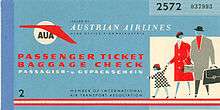Airline ticket


An airline ticket is a document or electronic record, issued by an airline or a travel agency, that confirms that an individual is entitled to a seat on a flight on an aircraft. The airline ticket may be one of two types: a paper ticket, which comprises coupons or vouchers; and an electronic ticket (commonly referred to as an e-ticket).
The ticket, in either form, is required to obtain a boarding pass during check-in at the airport. Then with the boarding pass and the attached ticket, the passenger is allowed to board the aircraft.
Details
Regardless of the type, all tickets contain the following information:
- The passenger's name.
- The issuing airline.
- A ticket number, including the airline's 3 digit code[1] at the start of the number.
- The cities the ticket is valid for travel between.
- Flight that the ticket is valid for. (Unless the ticket is "open")
- Baggage allowance. (Not always visible on a printout but recorded electronically for the airline)
- Fare. (Not always visible on a printout but recorded electronically for the airline)
- Taxes. (Not always visible on a printout but recorded electronically for the airline)
- The "Fare Basis", an alpha or alpha-numeric code that identifies the fare.
- Restrictions on changes and refunds. (Not always shown in detail, but referred to).
- Dates that the ticket is valid for.
- "Form of payment", i.e., details of how the ticket was paid for, which will in turn affect how it would be refunded.
- The Rate of Exchange used to calculate any international parts of the fare and tax.
- A "Fare Construction" or "Linear" showing the breakdown of the total fare.
Replacement of paper tickets

IATA announced that as of June 1, 2008, IATA-member airlines will no longer issue any paper tickets.[2]
A ticket is generally only good on the airline for which it was purchased. However, an airline can endorse the ticket, so that it may be accepted by other airlines, sometimes on standby basis or with a confirmed seat. Usually the ticket is for a specific flight. It is also possible to purchase an 'open' ticket, which allows travel on any flight between the destinations listed on the ticket. The cost for doing this is greater than a ticket for a specific flight. Some tickets are refundable. However, the lower cost tickets are usually not refundable and may carry many additional restrictions.
The carrier is represented by a standardized 2-letter code. In the example above, Thai Airways is TG. The departure and destination cities are represented by International Air Transport Association airport codes. In the example above, Munich is MUC and Bangkok is BKK. The International Air Transport Association is the standard setting organization.
Only one person can use a ticket. If multiple people are traveling together, the tickets are linked together by the same record locator or reservation number, which are assigned, if the tickets were purchased at the same time. If not, most airlines can cross-reference the tickets together in their reservation systems. This allows all members in a party to be processed in a group, allowing seat assignments to be together (if available at the time of the assignment)
Controversies
When paper tickets were still frequently used, a practice existed by travellers to get rid of their tickets (which are person-specific), when they decided to alter the course of their trips. This practice consisted of selling the ticket to other travellers (often at discount prices), after which the seller accompanied the buyer at the time of departure to the airport. Here, the original owner checked in under his name and provided the airline with the buyer's baggage. After this, the buyer boarded the airplane at the moment of departure.[3] However, since most airlines check identification on boarding, this procedure is rarely functional.
See also
Notes
- ↑ Airline and Airport Code Search
- ↑ "Industry Bids Farewell to Paper Ticket" (Press release). International Air Transport Association. 31 May 2008. Retrieved 17 October 2013.
- ↑ Timmerhuis, Frans (2007). Handboek Voor De Wereldreiziger (in Dutch). Rijswijk: Elmar. ISBN 978-9038917597.
External links
-
 The dictionary definition of paper ticket at Wiktionary
The dictionary definition of paper ticket at Wiktionary -
 Media related to Air tickets at Wikimedia Commons
Media related to Air tickets at Wikimedia Commons